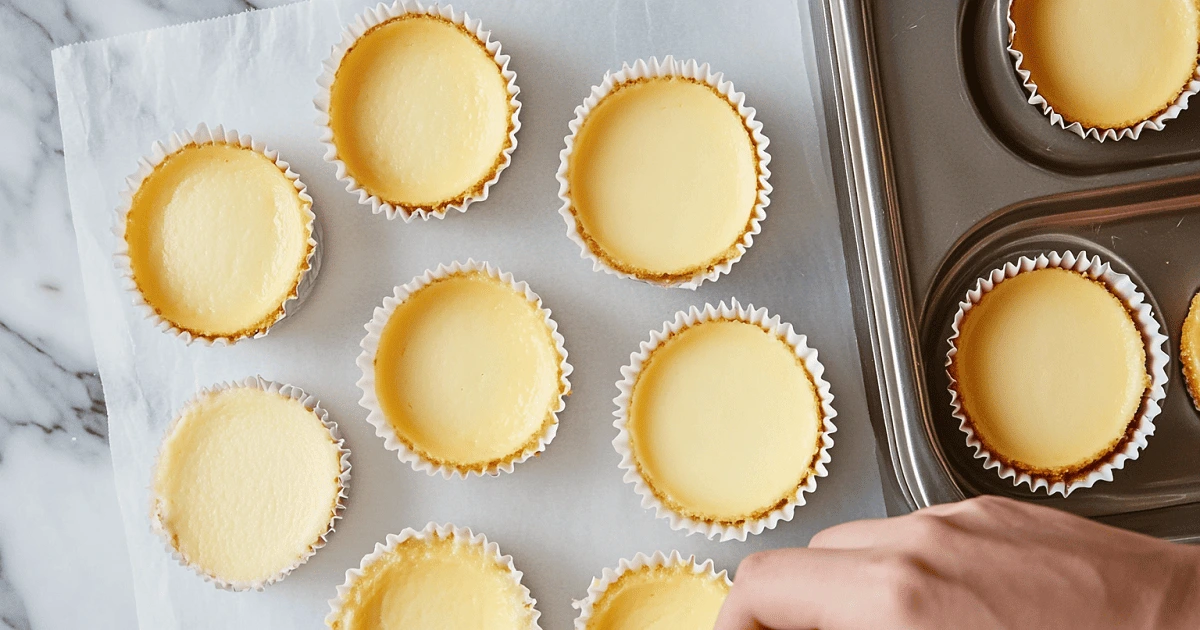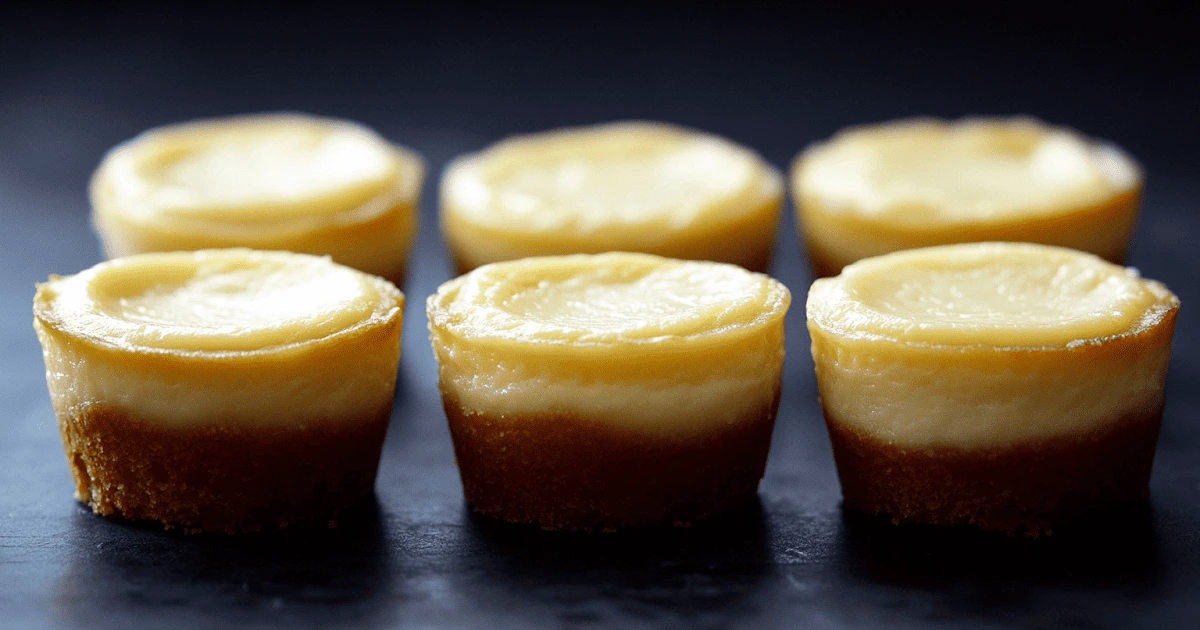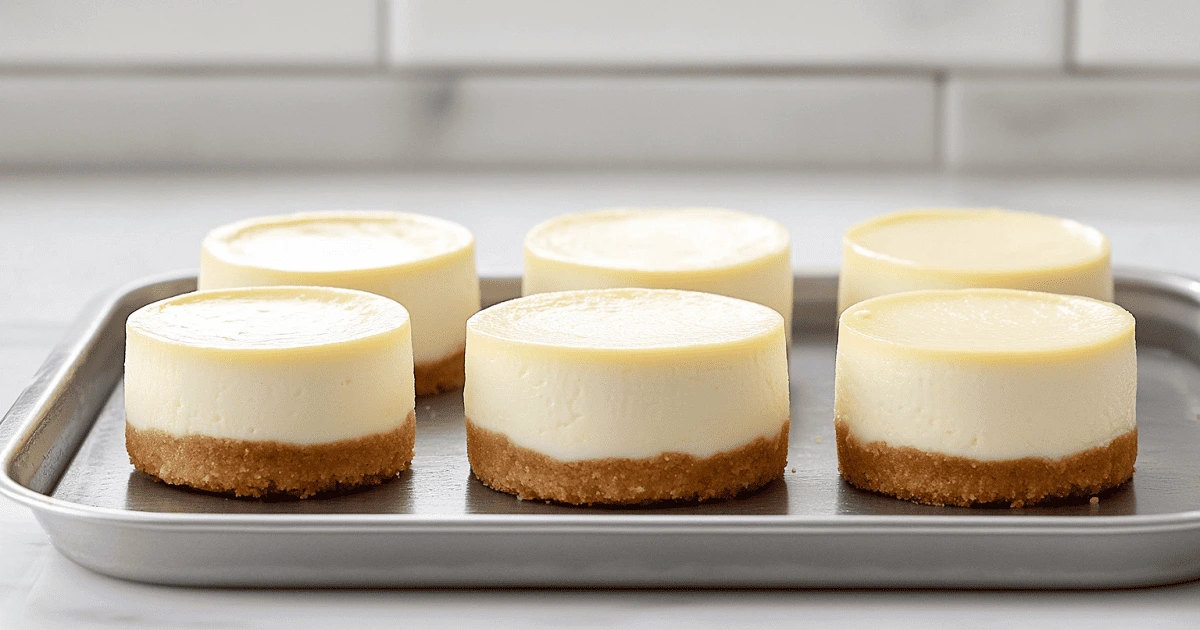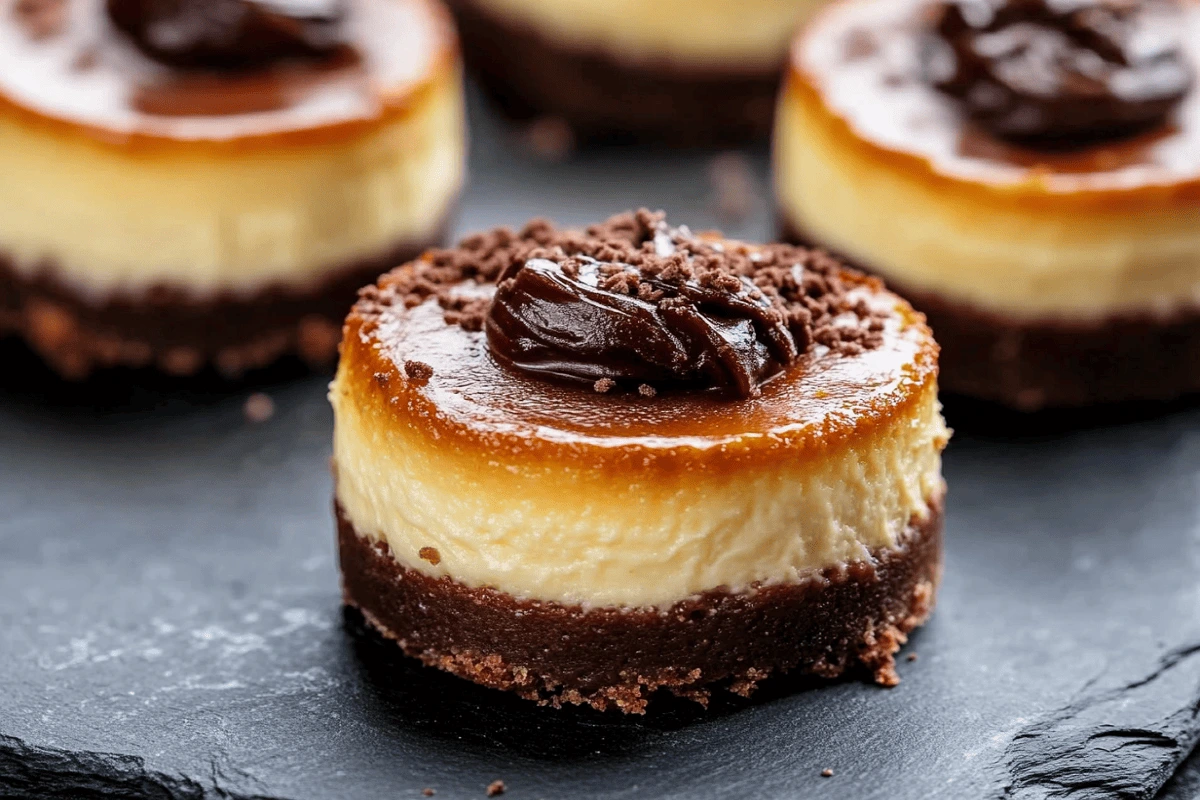Introduction: Timing Matters with Mini Cheesecakes
Wondering how do you know when mini cheesecakes are done? This question is one of the most searched by home bakers.
Mini cheesecakes are delightful for parties, holidays, and portion-controlled desserts. But when it comes to baking them just right, things get tricky. Overbake them, and you get dry, cracked tops. Undercook them, and you’re left with gooey centers that never set.
So, how do you know when mini cheesecakes are done? Discover the key signs, techniques, and expert secrets that guarantee perfectly baked mini cheesecakes every time.
According to Southern Living, the key to perfect cheesecake is learning to recognize visual and physical signs of doneness—especially since the traditional toothpick test doesn’t work well.
Also, baking experts at Bon Appétit recommend checking internal temperature to confirm when your cheesecakes are ready to cool.
1. How Do You Know When Mini Cheesecakes Are Done? Look for These 7 Signs
1.1. The Edges Look Set
The first visual cue is the edge. It should appear firm and slightly puffed. If the edges still look glossy or wet, it’s too early.
1.2. The Center Has a Gentle Jiggle
A small, subtle jiggle in the center is what you want. Too much movement means it’s undercooked. No jiggle at all may indicate overbaking.
1.3. The Top Is Smooth and Pale
The surface should look matte, not shiny. A light golden hue around the edges is fine, but browning across the top suggests overbaking.
1.4. The Cheesecakes Are Just Pulling from the Sides
A mini cheesecake that has just started to shrink away from the pan walls is ready to come out.
1.5. They Pass the Gentle Touch Test
Lightly press the center with a clean finger. It should feel soft but not wet, with slight resistance.
1.6. Thermometer Reads 150°F (65°C)
For guaranteed accuracy, insert a thermometer into one cheesecake’s center. The internal temp should hit 150°F.
1.7. They Don’t Stick to Your Finger
If you touch the top and your finger comes back clean, they’re likely done. If batter sticks, keep baking.
2. Why Cheesecake Doneness Is Harder to Judge Than Cake
Cheesecakes behave differently from cakes. They’re custards, so they don’t rise and spring back the same way. And toothpick testing doesn’t help—it only tears the top.
That’s why understanding visual and physical cues is essential. Mini cheesecakes can go from creamy to cracked in just minutes.
3. Recommended Baking Time and Temperature for Mini Cheesecakes
Baking mini cheesecakes takes less time than full-size versions. A few key factors influence the results:
-
Time: 15 to 20 minutes
-
Temperature: 325°F (163°C)
-
Pan Type: Mini muffin tin or individual cheesecake molds

To ensure even baking in ovens with hot spots, turn the pan around midway through the bake.
For consistent heat, use an oven thermometer. According to The Spruce Eats, even a 10-degree difference can affect doneness.
4. Cooling and Setting: The Final Step for Perfect Texture
Even after baking, understanding how do you know when mini cheesecakes are done includes knowing when they’re fully set during cooling.
Don’t judge cheesecake doneness by how it feels straight from the oven. It continues cooking while it cools.
Follow this cooling process:
-
Step 1: Turn off the oven and crack the door. Let cheesecakes sit for 30 minutes.
-
Step 2: Transfer to the counter and cool fully to room temperature.
-
Step 3: Refrigerate for at least 2 hours—ideally overnight.
This gradual cooling keeps the centers creamy and helps prevent cracking.
To apply these techniques to a practical recipe, try this simple yet delicious mini cheesecake recipe that yields consistent results.
5. Common Baking Mistakes That Lead to Undercooked or Overbaked Mini Cheesecakes
Many bakers struggle with overbaking because they don’t recognize how do you know when mini cheesecakes are done just by appearance alone.
Mini cheesecakes are sensitive to technique. Avoid these common errors:
❌ Overmixing the batter
-
Introduces air, which can cause bubbles and cracking.
❌ Baking too hot
-
High temperatures can brown the top and leave the inside undercooked.
- It also leads to dry, crumbly texture and cracked tops.
To avoid cracks in your cheesecakes, it’s helpful to understand why mini cheesecakes crack during baking, and how to prevent it. Mastering temperature control and using gradual cooling can make a big difference in appearance and texture.
❌ Removing too early
-
If undercooked, they won’t set even after refrigeration.
❌ Cooling too fast
-
Sudden temperature changes cause collapse or cracking.
6. How to Fix Mini Cheesecakes That Didn’t Set Properly
Sometimes even the best bakers miss the mark. If your cheesecakes come out underdone:
-
Rebake Method: If your mini cheesecakes are undercooked, return them to a 300°F oven and bake for an additional 5 to 8 minutes. Watch closely to avoid overbaking—you’re looking for set edges and a slight center jiggle. This method can help firm them up without drying them out.

-
Frozen Cheesecake Bites: If your mini cheesecakes are slightly underbaked, freeze them instead of rebaking. Once chilled, they firm up nicely and make rich, creamy frozen cheesecake bites. Serve them straight from the freezer for a cool, indulgent treat with a texture similar to ice cream—perfect for warm days or make-ahead desserts.
-
Topping Solution: If your mini cheesecakes have minor texture flaws, simply add a layer of whipped cream, fruit, or a drizzle of sauce. These toppings not only enhance flavor and presentation but also help conceal imperfections like cracks or uneven surfaces, making your desserts look polished and taste delicious.
7. Is It Better to Undercook or Overcook Cheesecake?
When it comes to cheesecake, slightly undercooked is far better than overbaked. An undercooked mini cheesecake may feel soft at first but will continue to firm up in the refrigerator, resulting in a creamy, smooth texture. On the other hand, an overbaked cheesecake often turns dry, rubbery, and cracked—issues that can’t be reversed.
Remember:
Undercooked = soft, creamy, and fixable
Overcooked = dry, dense, and disappointing
If you’re unsure, aim for a gentle jiggle in the center rather than waiting for the entire cheesecake to feel solid. That wobble is your best signal for doneness.
8. How Long Do You Bake a Mini Baked Cheesecake?
Here’s a cheat sheet based on pan and recipe type:
| Pan Type | Temperature | Bake Time |
|---|---|---|
| Mini Muffin Tin | 325°F | 15–17 minutes |
| Mini Springform Pan | 325°F | 18–22 minutes |
| Silicone Baking Cups | 325°F | 16–18 minutes |
Always watch for signs of doneness—don’t just rely on the timer.
9. Advanced Tips for Mini Cheesecake Success
-
Room Temperature Ingredients: Using ingredients like cream cheese, eggs, and sour cream at room temperature helps create a smooth, lump-free batter. Cold ingredients don’t blend evenly and can lead to a grainy texture. Let everything sit out for 30–60 minutes before mixing to ensure a creamy, consistent filling.
-
Avoid overmixing: Once the eggs are added to the batter, mix just until combined. Overmixing introduces excess air, which can cause cracks, puffing, and a spongy texture. Gentle mixing preserves the rich, dense consistency that makes mini cheesecakes smooth and creamy after baking.
-
Water Bath Method: Using a water bath when baking mini cheesecakes in springform pans helps maintain an even baking temperature. The steam prevents the cheesecakes from drying out and reduces the risk of cracks. This gentle method results in a smoother, creamier texture and a more professional-looking finish.
-
Avoid Early Oven Opening: Keep the oven door closed for at least the first 12 minutes of baking. Peeking too early can cause a sharp temperature dip, which often results in sunken centers and an uneven bake. Consistent heat is essential for mini cheesecakes to rise evenly and set properly.
10. FAQs

How do you tell if mini cheesecakes are done?
Look for firm edges, a slight center jiggle, a smooth top, and no batter sticking to your finger. Check for doneness by inserting a thermometer—you’re aiming for a center temperature of 150°F.
That’s exactly how do you know when mini cheesecakes are done—by using these seven visual and physical signs.
How to tell if cheesecake is done?
The same signs apply: slight jiggle, set edges, and pale top color. Use an internal thermometer for accuracy.
Is it better to undercook or overcook cheesecake?
Slight undercooking is better. Cheesecakes continue to set during cooling. Overcooking causes cracks and dry texture.
How long do you bake a mini baked cheesecake?
Bake 15–20 minutes at 325°F depending on pan type. Watch visual cues rather than just the clock.
Conclusion: You Now Know When Mini Cheesecakes Are Done
Mastering how do you know when mini cheesecakes are done is key to achieving the ideal balance of texture and flavor. With a little experience and attention to detail, you’ll develop the confidence to remove them at just the right moment—before they crack, and while the centers still show that signature gentle jiggle.
Keep these indicators in mind:
-
Golden edges mean they’re properly set
-
A slight jiggle in the middle ensures creaminess
-
A smooth, uncracked top signals baking success
Allow them to cool gradually, then chill thoroughly to finish setting. The result? A smooth, rich bite with a flawless finish—no overbaking, no guessing.
Once you’ve learned to identify these signs, how do you know when mini cheesecakes are done becomes second nature. Rely on these proven techniques, and your cheesecakes will consistently turn out picture-perfect and crowd-pleasing every time.

